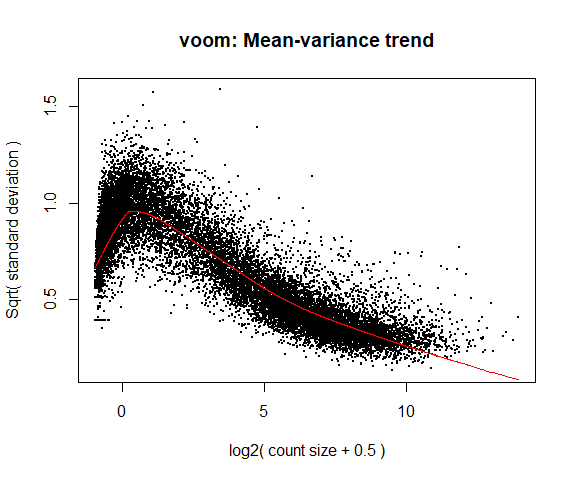Hey. I have bulk RNA-seq raw count data and metadata on hand.
The metadata have three independent variables: genotype (KO & WT), sex (F & M), and Rin (continuous).
I wanna see if KO vs. WT have significantly different gene expressions, when adjusting for sex and Rin.
I usedaov()andlm() in R to run the analysis, but got different p values for categorical independent variables, aka, genotype and sex. But for Rin (continuous variable), the p values are the same. I am wondering why that is. I also saw somewhere online that lm() and aov() can be considered identical, but why results are different from the two models. And more importantly, which p value should I trust and use?
Thanks!
Take one gene for example, my codes are here:
#anova
> ano<- aov(ENSMUSG00000051951~genotype+sex+rin, data = old.df)
> summary(ano)
Df Sum Sq Mean Sq F value Pr(>F)
genotype 1 0.1764 0.1764 1.517 0.2323
sex 1 0.7178 0.7178 6.174 0.0219 *
rin 1 0.4111 0.4111 3.536 0.0747 .
Residuals 20 2.3253 0.1163
---
Signif. codes: 0 ‘***’ 0.001 ‘**’ 0.01 ‘*’ 0.05 ‘.’ 0.1 ‘ ’ 1
#linear regression
> lmr<- lm(ENSMUSG00000051951~genotype+sex+rin, data = old.df)
> summary(lmr)
Call:
lm(formula = ENSMUSG00000051951 ~ genotype + sex + rin, data = old.df)
Residuals:
Min 1Q Median 3Q Max
-0.81176 -0.19161 0.07608 0.27481 0.50259
Coefficients:
Estimate Std. Error t value Pr(>|t|)
(Intercept) -2.7457 3.5691 -0.769 0.45072
genotypeWT -0.2575 0.1465 -1.757 0.09418 .
sexM -0.5916 0.1909 -3.099 0.00566 **
rin 0.7371 0.3920 1.881 0.07468 .
---
Signif. codes: 0 ‘***’ 0.001 ‘**’ 0.01 ‘*’ 0.05 ‘.’ 0.1 ‘ ’ 1
Residual standard error: 0.341 on 20 degrees of freedom
Multiple R-squared: 0.3595, Adjusted R-squared: 0.2635
F-statistic: 3.743 on 3 and 20 DF, p-value: 0.02772

 ) which in your case is left unmodeled:
) which in your case is left unmodeled:
The text font seems terrible, but I do not know how to adjust them. Please bear with me.
Select text you want to format as
codeand then use the101010button in the editor. I have done it for you this time.Thanks a lot!! Seems so better now. Will do it going forward.
Thanks for enlightening me of the distribution of the rawcount data.
I am so sorry for not mentioning that I have normalized the rawcounts and now they are in log2RPKM form. I see some papers using ANOVA for DEG, so I would like to try that. But I am just confused if I should use ANOVA or linear regression.
Normalized counts on log2 scale are still overdispersed (what LChart is showing in the plot) and is not accounted by the methods you mention. I think LChart's answer nails the essential points: Don't reinvent the wheel, use specialized software that outperforms ANOVA and lm. Really, just put the raw counts into DESeq2 or others and be done with it.
Thank you! Got it.